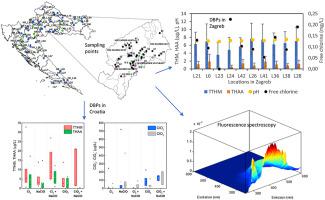Journal of Environmental Management ( IF 8.0 ) Pub Date : 2020-09-11 , DOI: 10.1016/j.jenvman.2020.111360 L Kurajica 1 , M Ujević Bošnjak 1 , M Novak Stankov 2 , A S Kinsela 3 , J Štiglić 1 , D T Waite 3 , K Capak 1

|
The occurrence of disinfection by-products (DBPs) was investigated in 48 drinking water systems across Croatia. Eleven DBPs were studied: chlorite (ClO2−), chlorate (ClO3−), four trihalomethanes (THMs), and five haloacetic acids (HAAs). Furthermore, an intensive sampling program was conducted in the distribution system in the city of Zagreb where, aside from DBP analyses, natural organic matter (NOM) was characterized using fluorescence spectroscopy. In the drinking waters examined across Croatia, DBP values were found in the range from 0.7 μg/L to 32.8 μg/L for THMs, below LOQ to 17.2 μg/L for HAAs (primarily di- and trichloroacetic acids), below LOQ to 720 μg/L for ClO2− and below LOQ to 431 μg/L for ClO3−. The results obtained showed higher chlorite concentrations in the systems treated with hypochlorite compared to systems treated with chlorine dioxide. DBPs in the Zagreb distribution network were generally low (the average values were below 6 μg/L and 2 μg/L for total THM and total HAA respectively). In contrast to our observations throughout Croatia, dibromoacetic acid (DBAA) was found to be the predominant HAA within Zagreb, most likely due to the degradation of chlorinated carboxylates (di-/tri-chloroacetic) in the network. Characterization of NOM by Parallel Factor Analysis (PARAFAC) fluorescence spectroscopy across the Zagreb network showed distinct temporal variations arising from groundwater inputs, as evident from variable humic-, tyrosine-, and tryptophan-like peaks. Statistical correlations between fluorescence data and DBPs highlight its potential for monitoring the presence of DBPs in distribution networks.
中文翻译:

克罗地亚饮用水供应中的消毒副产品,特别着重于萨格勒布市的供水网络。
在克罗地亚的48个饮用水系统中对消毒副产物(DBP)的发生进行了调查。十一消毒副产物进行了研究:氯酸钠(CLO 2 - ),氯酸根(CLO 3 - ),四三卤甲烷(三卤甲烷)和五个卤乙酸(卤乙酸)。此外,在萨格勒布市的配送系统中进行了密集采样程序,该地区除了进行DBP分析外,还使用荧光光谱法表征了天然有机物(NOM)。在克罗地亚各地检查的饮用水中,三卤甲烷的DBP值范围为0.7μg/ L至32.8μg/ L,HAAs(主要为二氯和三氯乙酸)的LOQ至LOQ的17.2μg/ L,LOQ为720以下的范围微克/升CLO 2 -和低于LOQ到431微克/升CLO 3-。获得的结果表明,与用二氧化氯处理的系统相比,用次氯酸盐处理的系统中的亚氯酸盐浓度更高。萨格勒布分销网络中的DBP通常较低(总THM和总HAA的平均值分别低于6μg/ L和2μg/ L)。与我们在整个克罗地亚的观察结果相反,发现二溴乙酸(DBAA)是萨格勒布内部的主要HAA,最有可能是由于网络中氯化羧酸盐(二/三氯乙酸)的降解。通过萨格勒布网络上的并行因子分析(PARAFAC)荧光光谱对NOM进行表征,显示出地下水输入引起的明显时间变化,从腐殖酸,酪氨酸和色氨酸样峰的变化可以明显看出。











































 京公网安备 11010802027423号
京公网安备 11010802027423号